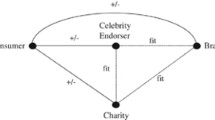Abstract
This paper tests the assumption that consumers’ perceptions of fit between brand alliance partners can serve different roles in attitude formation depending on the level of elaboration given to a persuasive message about a brand alliance. We experimentally manipulate fit between brand concepts of real brands, situational involvement, and argument quality to test this assumption. A three-way interaction showed a positive main effect of fit on alliance attitude under low involvement and an interaction between fit and argument quality on alliance attitude under high involvement. Consequently, brand owners could expect more beneficial behavioral consequences of alliance attitudes if they are (a) based on alliances between brands with similar brand concepts, (b) backed with strong arguments, and (c) perceived as personally relevant by target consumers. The paper adds insight into how fit between the alliance partners can assume different roles as persuasion variables, thereby extending our understanding of theoretical mechanisms explaining when and why fit is important between brand alliance partners.

Similar content being viewed by others
References
Aaker, D. A., & Keller, K. L. (1990). Consumer evaluations of brand extensions. Journal of Marketing, 54(1), 27–41.
Anderson, J. R. (1983). The architecture of cognition. Cambridge: Harvard University Press.
Arnett, D. B., Laverie, D. A., & Willcox, J. B. (2010). A longitudinal examination of the effects of retailer-manufacturer brand alliances: the role of perceived fit. Journal of Marketing Management, 26(1–2), 5–27.
Bhat, S., & Reddy, S. K. (1998). Symbolic and functional positioning of brands. Journal of Consumer Marketing, 15(1), 32–43.
Gürhan-Canli, Z., & Maheswaran, D. (1998). The effects of extensions on brand name dilution and enhancement. Journal of Marketing Research, 35(November), 464–473.
James, D. O. (2006). Extension to alliance: Aaker and Keller’s model revisited. Journal of Product and Brand Management, 15(1), 15–22.
Lane, V. R. (2000). The impact of ad repetition and ad content on consumer perception of incongruent brand extensions. Journal of Marketing, 64(2), 80–91.
Lanseng, E. J., & Olsen, L. E. (2012). Brand alliances: the role of brand concept consistency. European Journal of Marketing, 46(9), 1108–1126.
Lee, E.-J., & Schumann, D. W. (2004). Explaining the special case of incongruity in advertising: combining classic theoretic approaches. Marketing Theory, 4(1/2), 59–90.
Maheswaran, D., & Chaiken, S. (1991). Promoting systematic processing in low motivation settings: the effect of incongruent information on processing and judgment. Journal of Personality and Social Psychology, 61(July), 13–25.
Mandler, G. (1982). The structure of value: accounting for taste. In M. S. Clark & S. T. Fiske (Eds.), Affect and cognition: the 17th Annual Carnegie Symposium on Cognition (pp. 3–36). Hillsdale: Lawrence Erlbaum.
Meyers-Levy, J., & Tybout, A. M. (1989). Schema congruity as a base for product evaluation. Journal of Consumer Research, 16(June), 39–54.
Park, C. W., Jaworski, B. J., & MacInnis, D. (1986). Strategic brand concept image management. Journal of Marketing, 50(4), 134–145.
Park, C. W., Jun, S. Y., & Shocker, A. D. (1996). Composite branding alliances: an investigation of extension and feedback-effects. Journal of Marketing Research, 33(4), 453–466.
Petty, R. E., & Cacioppo, J. T. (1986). Communication and persuasion: central and peripheral routes to attitude change. New York: Springer Verlag.
Petty, R. E., & Wegener, D. T. (1998). Matching versus mismatching attitude functions: implications for scrutiny of persuasive messages. Personality and Social Psychology Bulletin, 24(3), 227–240.
Petty, R. E., Cacioppo, J. T., & Schumann, D. W. (1983). Central and peripheral routes to advertising effectiveness: the moderating role of involvement. Journal of Consumer Research, 10(2), 135–146.
Rosch, E. (1978). Principles of categorization. In E. Rosch & B. B. Lloyd (Eds.), Cognition and categorization (pp. 27–48). Hillsdale: Lawrence Erlbaum Associates.
Simonin, B. L., & Ruth, J. A. (1998). Is a company known by the company it keeps? Assessing the spillover effects of brand alliances on consumer brand attitudes. Journal of Marketing Research, 35(1), 30–42.
Swaminathan, V., Reddy, S., & Dommer, S. (2012). Spillover effects of ingredient branded strategies on brand choice: A field study. Marketing Letters, 23(1), 237–251.
Woods, W. A. (1960). Psychological dimensions of consumer decision. Journal of Marketing, 24(3), 15–19.
Zaichkowsky, J. L. (1994). The personal involvement inventory: reduction, revision, and application to advertising. Journal of Advertising, 23(4), 59–70.
Acknowledgments
The authors would like to thank student Martin Stenstad for his efforts in data collection and Luk Warlop for comments on an earlier version of this manuscript.
Author information
Authors and Affiliations
Corresponding author
Rights and permissions
About this article
Cite this article
Samuelsen, B.M., Olsen, L.E. & Keller, K.L. The multiple roles of fit between brand alliance partners in alliance attitude formation. Mark Lett 26, 619–629 (2015). https://doi.org/10.1007/s11002-014-9297-y
Published:
Issue Date:
DOI: https://doi.org/10.1007/s11002-014-9297-y




